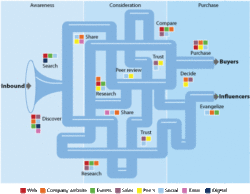47% of companies reported to HubSpot that their top sales priority for next year is to improve the efficiency of their sales funnel. 72% reported that their top sales goal was to close more deals. We’d argue that in order to close more deals, you have to improve the efficiency of your funnel first.
Sometimes when you’re buried in selling, you forget to take a step back and look at the bigger picture. What is your company’s sales strategy? Are you and your team on the same page about that process? What stages is the buyer going through before their purchase? More importantly, how is the buyer processing information in each of those stages?
Recently, we collaborated with a client to redefine their sales funnel and investigate ways to increase efficiency. We recommend reviewing your sales strategy and realigning it with the Buyer’s Journey. Here are some considerations:
Before you begin analyzing your sales funnel and strategy, it is critical to define the terms that go along with it.
Create common definitions so you and your team are on the same page when evaluating who is classified as a sales qualified lead vs. marketing qualified lead. What actions and behaviors move a lead from one stage to the next? At what point is a lead ready for a sales call? How long should a lead be considered an opportunity before they are brought back to the beginning of the funnel?
The sales funnel has not one, but two components – the Sales Journey and the Buyer’s Journey.
Don’t forget to take into consideration both when assessing your sales process. What’s the difference? The Sales Journey is the internal strategy you use to sell (i.e. how you turn a lead into an opportunity). The Buyer’s Journey is the future customer’s passage from awareness of your product or service to the decision to purchase your product or service.

Source: HubSpot
The most critical part about the Buyer’s Journey is the emotional and rational decision-making of the future customer.
Note that when someone is in the Awareness Stage, they are acting more emotionally than rationally (I really want a new car). As he/she advances through the journey, he/she starts to become more rational about the purchasing decision and less emotional (I am considering buying a new or used car and researching gas mileage and safety).
By the time the customer is ready to purchase, he/she has become more emotional and less rational again (I know I need a new car and I really want that car). Finally, when he/she is a customer and loyal to your brand, he/she remains emotional but becomes rational too (I love this car because it has high safety ratings; I will never buy another car model).

We tend to think of the sales funnel in linear terms, but in reality, it is much more complex.
No, your customers aren’t going straight from awareness to consideration to purchase. They don’t (typically) become a lead and then an opportunity in the same week. In reality, there are endless factors that go into someone’s decision to make a purchase. You can still think of it in linear terms, but don’t forget what is truly going through your customer’s mind.

Source: Forrester Research
Look for bottlenecks in the sales funnel and take the time to determine why leads are getting stuck there.
If you have future customers stuck as sales qualified leads or opportunities, it may be time to create more ROI or data-based content as they are in the more rational consideration phase of the Decision Making Journey.
Is there any knowledge you have about that customer that could help you move them to the next stage? What holes are there in your selling strategy? How can targeted campaigns help communicate the strongest information for that particular person? For more information on targeted campaigns, read this case study from HubSpot on how targeted campaigns can increase revenue.
At the end of the day, it’s about working to align the Sales Journey with the Buyer’s Journey. It will never feel perfect, but the more effort you make to align them, the more effective you’ll be in communicating the right messages at the right time to the right customers. If you are one of the 47% of companies that is looking to improve the efficiency of your sales funnel this year, we recommend following the above steps to get started on your journey to efficiency.
